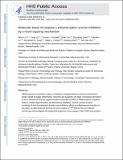Molecular basis of caspase-1 polymerization and its inhibition by a new capping mechanism
Author(s)
Lu, Alvin; Li, Yang; Schmidt, Florian I; Yin, Qian; Chen, Shuobing; Fu, Tian-Min; Tong, Alexander B; Mao, Youdong; Wu, Hao; Ploegh, Hidde; ... Show more Show less
DownloadPloegh_Molecular basis.pdf (5.084Mb)
OPEN_ACCESS_POLICY
Open Access Policy
Creative Commons Attribution-Noncommercial-Share Alike
Terms of use
Metadata
Show full item recordAbstract
Inflammasomes are cytosolic caspase-1-activation complexes that sense intrinsic and extrinsic danger signals, and trigger inflammatory responses and pyroptotic cell death. Homotypic interactions among Pyrin domains and caspase recruitment domains (CARDs) in inflammasome-complex components mediate oligomerization into filamentous assemblies. Several cytosolic proteins consisting of only interaction domains exert inhibitory effects on inflammasome assembly. In this study, we determined the structure of the human caspase-1 CARD domain (caspase-1[superscript CARD]) filament by cryo-electron microscopy and investigated the biophysical properties of two caspase-1-like CARD-only proteins: human inhibitor of CARD (INCA or CARD17) and ICEBERG (CARD18). Our results reveal that INCA caps caspase-1 filaments, thereby exerting potent inhibition with low-nanomolar K[subscript i] on caspase-1[superscript CARD] polymerization in vitro and inflammasome activation in cells. Whereas caspase-1[superscript CARD] uses six complementary surfaces of three types for filament assembly, INCA is defective in two of the six interfaces and thus terminates the caspase-1 filament.
Date issued
2016-04Department
Massachusetts Institute of Technology. Department of Biology; Whitehead Institute for Biomedical ResearchJournal
Nature Structural & Molecular Biology
Publisher
Nature Publishing Group
Citation
Lu, Alvin et al. “Molecular Basis of Caspase-1 Polymerization and Its Inhibition by a New Capping Mechanism.” Nature Structural & Molecular Biology 23.5 (2016): 416–425.
Version: Author's final manuscript
ISSN
1545-9993
1545-9985